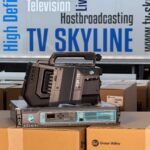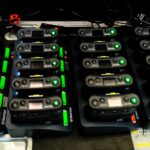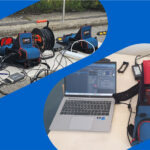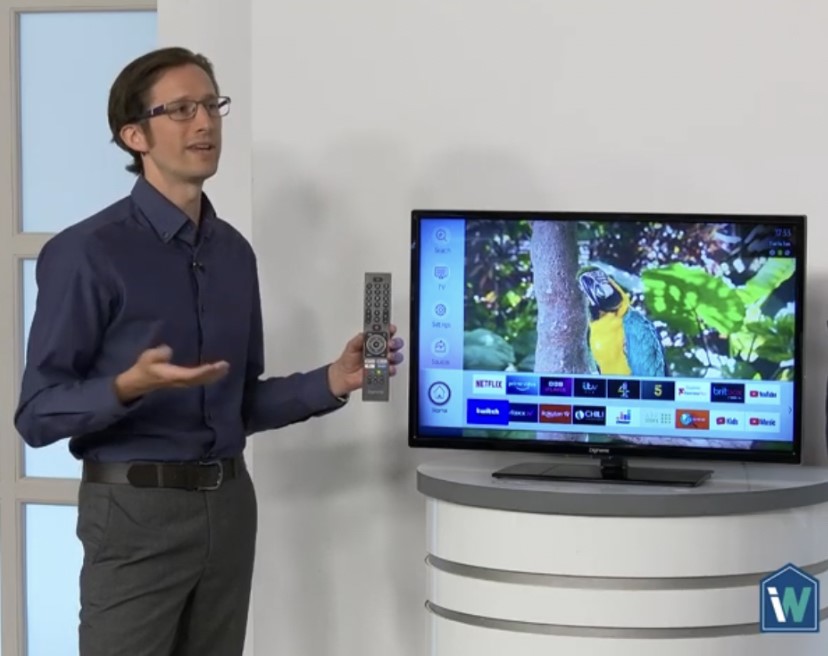After 18 years in production, Ideal World TV’s Head of Technology Stuart Dunnett has been there, seen it and got the t-shirt.
We speak exclusively to him about his role, the future of the industry and the challenges of running a live television channel for more than 20 hours a day.
What equipment do you typically use on a day-to-day basis?
Video wise, the main Ideal World Studio runs on two banks of 6x Panasonic PTZ cameras coupled with traditional manually operated Sony HDC1500 chain cameras for the best of both worlds.
We have pre-vis stations in the live studio so we can set robotics shots for each show up an hour before it goes live.
These are switched through a Ross Carbonite mixer with Grass Valley, SAM legacy VT and live replay systems.
We have bespoke version of the ImageOn stills system for photography and still grabs.
Audio is provided by Sony BWT series mics and a Yamaha QL1 mixer, remote controlled by a custom touch screen Provisonaire layout.
Our graphics engines are also bespoke to the channel built on Pixel Power hardware.
Behind the scenes we have our own on site MCR powered by Pebble playout and a variety of Grass Valley routing to get to our encoders.
What are the biggest technical challenges you face operating a TV channel 20 plus hours a day? How do you overcome them?
Because you are live 20, 21 hours a day, you only have three to four hours a day to get other stuff done and that can be a big challenge.
There’s not much of chance to do any big maintenance projects and it also means the equipment is in use so long you don’t get to do software updates either.
In other words, you don’t get to really test anything out.
We can’t have another full studio as a test environment, so if we’re making changes will make sure that they are small and they are planned.
You’ve got to make sure that everything has been planned out. Although we plan up to two weeks ahead, we might change schedules on the day.
Sometimes we’ll go back to a successful show in the previous days or previous weeks and say right, this is the layout, this is the camera setup, this is the short list.
We’ll look at what we know worked well for that show and if needbe we can get it changed with a couple of hours’ notice.
The biggest technical challenge is time, because any change you’re going to make is potentially going to impact your ability to go live three hours later.
What is your favourite part of the job?
It’s got to be when you’re making the sales.
That feeling of knowing you’ve done the job right and somebody at home has been motivated enough to spend their hard-earned money on the product you’re presenting.
That’s the really satisfying part.
I know it’s away from the technical part the of the role, but knowing we’ve done everything right – from getting the right product into the business to putting it on TV and demonstrating it in a way that somebody relates and realises ‘this is something I want’.
That means we’ve done the customer experience right. They’ve got the product at home and they’ve gone ‘yes it does work exactly as seen on TV’ and they really enjoying it.
It still puts a smile on people’s faces because we can see all the products flying out the door on our live scoreboard system when the shows are going on air. Everyone still gets a buzz from that.
Give us an idea of your typical day
There are no real typical days in this company or this industry!
It’s like a series of surprises and challenges and I probably wouldn’t have been here for 18 years if it wasn’t.
Each day is different. There’s always something cropping up, always something different just about to happen
In terms of my day, I’ve been recently promoted into the Head of Technology role, so I look after the broadcast operations as well as the IT teams on site.
The main part of my role is really about those teams. It’s far more about the people now.
I’ve got to make sure that everyone is well informed and they know everything they need to know.
What’s happening today, what’s happening this week, what’s happening this month and then long-term projects.
I have to make sure they’ve got all the help all the tools and all the systems they need to complete their work.
We have a sales and strategy meeting every morning to discuss what’s been selling well this week, whether there’s anything we want to do again, if there is something that sold out that we need to replace etcetera.
Sometimes we will reschedule to react to events in the world or even things like weather conditions.
For example, if it’s a lot colder that week, do we need to be doing warm weather clothing? Do we need to be doing electric heaters because other people don’t turn the gas on now?
We’ve got heated jackets at the moment, so for all the parents who were stood on the touchline on a Sunday you can put the battery pack in your jacket and it warms you up.
Every day I walk the studio floors and I’ll always walk over the technical areas make sure all the crews and engineers have a chance to talk to me.
I also make my own visual checks to see if there’s anything that might need updating or changing.
It’s important to talk to all the people who are at the business end on the studio floor.
Those are the guys using the kit, using the tech every day, and they are the ones who are going to come up with the best ideas. The best ways to change things, improvements they want making.
If you’re on air 20 hours a day and you can improve somebody’s working day by 2%, find that little thing that’s annoying them and get rid of it, it makes a big difference.
I’m always keen to hear their suggestions and then from the management part I like to spend time with all the other department heads to find out what they want from engineering, what they want for my team and then try to prioritise their workload and distribute them across the team, while making sure the timescales are realistic.
We’ve got a lot of a lot of long-term projects in the pipeline at the moment so my typical day will be spent making sure they are on track, and everybody’s got what they need to get on with them.
What do you think is the biggest challenge the industry is facing?
What we do at Ideal World TV is shoppable video content. The biggest challenge is that it seems to be everywhere at the moment.
If you look on Tik Tok, Instagram or even YouTube, they are all exploring video shopping now.
Loads of platforms and businesses you’ll see trying to do their own version of shopping TV ,but I don’t know if they even realise what they’re trying to make is shopping TV.
Making content readily accessible and interactive is essential, but it needs to be smooth for the customer. It needs to be easier for them to purchase from.
That’s the way the Ideal World is moving. That’s what is going to keep our version of shopping TV relevant.
We’re very, very good at making shoppable TV content but are we putting the right products in the right places right now? That’s what we’re looking at.
We’ve got a lot of things in the pipeline too with other brands and suppliers asking us to make their shoppable content as we are the experts.
What would you change about the industry?
The thing I’d probably want to change most is the perception from other parts of the TV world.
Somehow, I think a lot of people see shopping TV as like a lesser form of television. Somewhere in the lower forms of TV making.
But I’m proud of what our teams do here and what they create.
There are no rehearsals, no script, there’s no autocue and yet we’ve got teams here that still make 20 hours of engaging TV 364 days a year.
That deserves a huge level of respect, because if you went to any other TV channel and asked them to go live 20 hours a day with no rehearsals, no script and no autocue I doubt they’d be able to do it.
So yeah, I think the one thing I would try to change is the perceptions from other industries that we’re not quite as good or as capable.
We’ve produced some fantastic talents that have gone to other forms of television.
They all reference their grounding in shopping TV as what has made them a great camera operator or a great vision mixer.
How important do you think Virtual Reality will be to shopping TV going forward?
With shopping television it’s always been about setting the scene, putting the customer in our place and giving them examples of how a product can be used, so with VR systems we can do just that.
Using VR, we can show the product in the setting it will be used in and invite the customer in to join the experience.
That’s something we’re exploring now with the camera mapping technology.
With the emotion recognition technology we’ve got available to us and with some simple AR engines, Unreal Engine etcetera, we’ve got in house programmers who are experimenting with that it is going to be a really exciting time.
If we’re selling winter coats you could see somebody in a winter coat and using VR we could put them walking the dog down a country lane.
Then we can keep changing the weather – let’s have it snowing on them let’s have it raining on them.
We can use VR to set the scene so we can see where these products will be used and why are they useful.
We often do hot tub shows through the summer and put them in our studio garden.
We could use VR to set the scene and show you how much space they take up in an average sized garden or on a deck or under pagoda and do all that without having to physically change the set.
How do you ensure audio is of a consistently high quality?
The audio quality is actually a really tough thing to do and get right.
We’re in a shared studio space, so you’re always going to get a bit of general noise, a bit of studio bustle in the mix and then we have fashion shows and fitness shows where you’ve got models getting changed or people on exercise bikes.
Obviously then you’re going to get a bit of body noise.
We’re always listening and monitoring all the time to see if there’s something we can improve – if the mic is in the incorrect position, if there’s anything wrong with it.
We have good floor managers who are very good at controlling when there’s noise on the floor. If there’s something unavoidable with moving a piece of furniture they’ll wait until there’s a break.
The Sony BWT’s we are using are really reliable, really robust, which obviously helps massively.
Let’s talk a bit about you. How did you come to be in production?
I’m actually a music graduate! I did a three-year music degree, part way through which I decided ‘you know what I really would like to work in the television end of the musical backgrounds’.
I’ve got a bit of a creative urge but I’m from a family of electrical engineers so I’m kind of naturally technically aspirated without the desire to be really creative.
I was coming out of university in 2004 and was looking for my first job in television.
I’m Peterborough native anyway, where the Ideal World TV channel is based, so I saw an entry level role for a transmission operator and applied.
Bear in mind this is transmission when we were still broadcasting in 4×3 and all the shows were recorded onto IMX Mag Tape, so it wasn’t the cutting-edge environment we were working in now!
I was a little behind the times for a few years, but finally caught up working in that role.
It was when I saw the session studio director I thought ‘that’s what I want to do’, because it’s a good mix of creative and technical all in one.
Directors here also vision mix and I thought ‘that’s really cool, you get to push all the buttons and you get to be quite creative’ I think that’s what I want to do.
I started that position in 2008 and I’ve been zigzagging around the company into different roles ever since!
I was supervising director for a few years and then I was leading the studio director teams from 2014 for audio with sister channel Create and Craft.
Then in 2017 up came a production manager job because I was taking more of an interest in the commercial side of the business.
So, I went into production then came back to technical in 2019. I started to oversee all the studio directors for all the channels and all of the technical operators for the studio floor as well.
It’s at that point where I started to condense and merge those roles together.
We’ve now got the studio directors wrapped in vision mix and doing their own audio and driving their own robotics and do their own VT playback as well, so it’s a big multi-skilled job.
That’s been a big part of my role for the last few years – merging all those positions into like a single super operator position in the gallery.
Then very recently I’ve been promoted to Head of Technology.
This is a new role and the idea of it is for the business to blend the need for the IT and the broadcast infrastructure to crossover.
So, I’m looking at the best available technologies from both worlds to look at new ways of distributing their content.
I’ve also recently started doing a bit of presenting, as you can see from the picture.
I’m obsessed with coffee, so selling coffee machines made sense and sort of came naturally because I love talking about it!
How difficult have the last two years been for the industry with Covid and the subsequent recovery?
As far as we were concerned business is going very well.
During lockdown obviously all the shops were closed, so the only way people could shop was online or on the TV,
Things like fashion, cooking and gardening over the lockdown were very popular so we sold a lot of products relating to those.
For people stuck at home there was a shop that was interactive, that was friendly, that was live.
Business was actually really strong for us through the lockdown and staff wise we’ve held full time staff all the way through, which we feel very fortunate for.






